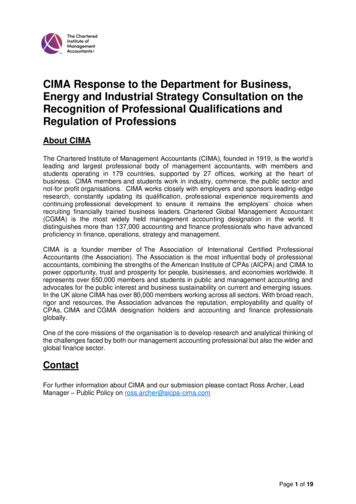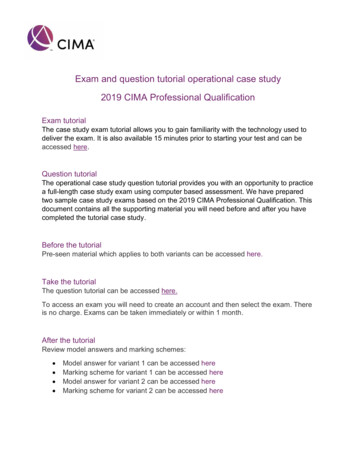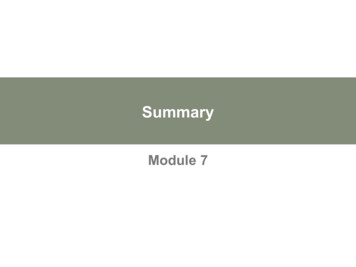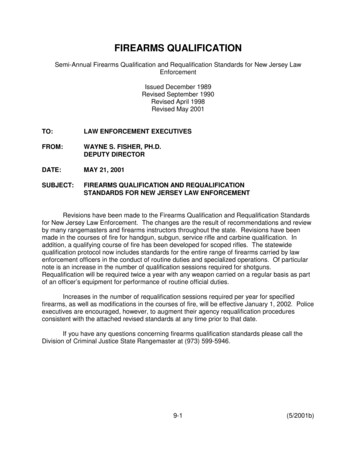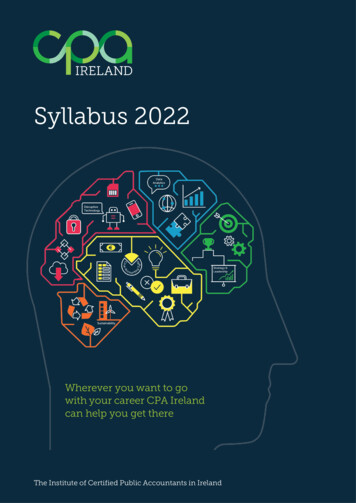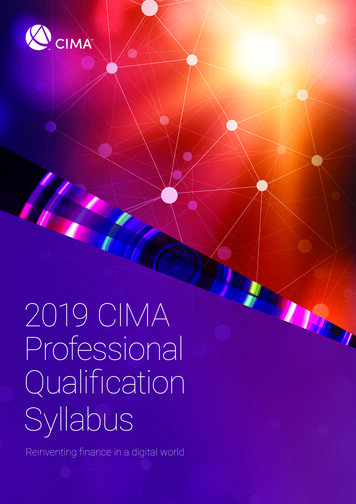
Transcription
2019 CIMAProfessionalQualificationSyllabusReinventing finance in a digital world
“ Digitalisation is transforming all industries. This is why digitalskills should be conveyed at all levels and in all forms ofeducation.”Contents2Foreword20 E1: Managing Finance in a Digital World3Contents32 P1: Management Accounting4The CIMA Professional Qualification42 F1: Financial Reporting5The CIMA Qualification Framework52 The Management Level6The CGMA Competency Framework56 E2: Managing Performance8Structure of the CIMA Syllabus64 P2: Advanced Management AccountingJoe Kaeser, President and CEO Siemens AGForewordI am pleased to introduce the 2019 CIMA Professional Qualification Syllabus, which further strengthens ourcommitment to the employability needs of both business and people, and underpins the CGMA designation.In an increasingly digital world, rapid changes in technology are creating challenges for the business models oforganisations. It is also making it difficult for business leaders and employees to create and preserve sustainablevalue. Against this digital backdrop, it is imperative that finance professionals possess relevant technical skills, asound understanding of their organisation, as well as the ability to influence and lead people. This will make themcapable of providing the insight their organisations need to craft and successfully execute their strategies.The 2019 syllabus continues to bridge the skills gap of newly qualified finance professionals worldwide, meetingthe employability needs of both business and people. In designing the syllabus, we set out to enhance the relevanceof the syllabus to employers; ensure the rigour of the related examinations and align the learning experience ofcandidates to the real world.The changes in the syllabus are based on our three-stage research approach of employer interviews, roundtablesand a global survey to a range of stakeholders. We contacted over 6,500 finance professionals, from over 2,000organisations, in over 150 countries. We have used the same research methodology as the previous syllabusupdate but on a larger scale and with wider participation. This research has allowed us to capture the latest viewsof finance professionals so that we can incorporate these into the syllabus.Importantly, the updated syllabus includes how the digital world affects finance; this can be seen through theintroduction of digital costing and digital strategy. Topics such as cybersecurity and business models have alsobeen incorporated. Existing areas, such as integrated reporting, have been expanded to reflect their growingprominence. Ultimately, these topics support CIMA’s desire to produce competent and confident managementaccounting professionals who can guide and lead their organisations to sustainable success.10 Learning outcomes and Exam blueprints74 F2: Advanced Financial Reporting12 CIMA assessment strategy86 The Strategic Level12 Suggested order of exams90 E3: Strategic Management14 T he syllabus in the context of the financefunction104 P3: Risk Management15 Summary of the 2019 SyllabusIncreasingly, the required skills of finance professionals are moving into theexpert,problem-solving arena and they must adopt competencies involved in influencing andchange management. The finance professional needs a mindset that enables them to adaptthrough continuous learning.Theymust 2 CIMA Professional Qualification Syllabus124 Exam information and timetable16 The Operational LevelI strongly recommend the CIMA Professional Qualification to employers and to those wishing to pursue asuccessful and rewarding career in business.Noel Tagoe, Ph.D., FCMA, CGMAExecutive Vice President — MA Research and Curricula114 F3: Financial StrategyChallengesPerformanceRealise the challengesorganisations facewhich threaten theirsuccessComprehend theperformance neededfrom the financeteam to addressthose challengesMindset andcompetenciesUnderstand thecompetencies andmindset neededto perform at therequired levelLearningsystemsUse learning tocontinually updatetheir competenciesand maintain a flexiblemindset for newchallenges3
The CIMA Professional QualificationThe CIMA Qualification FrameworkCIMA’s objective in designing the syllabus is to enhancethe employability of students and members. It intendsto create a learning system that enables learners toacquire skills, competencies and mindsets that are inhigh demand by employers. This has never been moreimportant with the pace of change increasing andtraditional roles being redefined by technology anddigital advances.The diagram below shows the CIMA Qualification Framework. This includes the Certificate in Business Accounting;the Professional Qualification; Assessment of Practical Experience; and Continuing Professional Development (CPD)in the form of lifelong learning.The Professional Qualification comprises three pillarsof domain knowledge divided into three levels ofachievement. The pillars are Enterprise, Performance andFinancial. The levels are Operational, Management andStrategic. When combined with the required practicalexperience, CIMA qualified members will be capableof supporting and leading their organisations throughthe challenging environment of constant change.The syllabus, assessments and practical experiencerequirements ensure members are competent in theessential accounting, finance and business-related skills.It also provides them with the skills required to lead thefinance function in a digital age.To complete the CIMA qualification, and be able touse the Chartered Global Management Accountant (CGMA ) designation, students need to:AWARD: Membership of the Chartered Institute of ManagementAccountants (ACMA/FCMA) and the CGMA designation M eet the entry requirements of the professionallevel qualification. S tudy for and complete the relevant professionallevel assessments, culminating in the StrategicCase Study Exam.Assessment of practical experience requirements (PER)StrategicLevel C omplete three years of relevant practicalexperience, which can be gained before,during and/or after studies.ManagementLevelStrategic Case Study alStrategyAWARD: CIMA Advanced Diploma in Management Accounting (CIMA Adv Dip MA)E2P2F2ManagingPerformanceAdvanced ManagementAccountingAdvanced FinancialReportingOperationalLevelAWARD: CIMA Diploma in Management Accounting (CIMA Dip MA)Operational Case Study ExamE1P1F1Managing Financein a Digital ise pillarCertificateLevelPerformance pillarPractical experience / lifelong learningManagement Case Study ExamFinancial pillarAWARD: CIMA Certificate in Business Accounting (CIMA Cert BA)BA1BA2BA3Fundamentals ofBusiness EconomicsFundamentals ofManagement AccountingFundamentals ofFinancial AccountingBA4 Fundamentals of Ethics,Corporate Governance and Business Law4 CIMA Professional Qualification Syllabus5
The CGMA Competency FrameworkThe CGMA Competency Framework was first introducedwith the 2015 syllabus. It set out the skills andcompetencies that employers identified as essentialfor their finance staff across a range of industries,organisation sizes and role levels within an organisation.To update both the syllabus and competency framework,we once again undertook global research to betterunderstand what is changing for both the financefunction within the organisation and the financeprofessional, against the backdrop of an ever-increasingdigital world.Our three-stage research approach of employerinterviews, roundtables and a global survey to arange of stakeholders, meant that we reached outto over 6,500 finance professionals, from over2,000 organisations, in over 150 countries, toanswer the following questions; How will the future be different for your organisation? What are the drivers of change for your organisation?The digital world, in which organisations now operate,is changing rapidly and in unpredictable ways. Ourresearch shows that technology is seen as the keydriver of change for both organisations and their financefunctions. Technology is transforming what financeprofessionals do, and revolutionising how the financefunction is being deployed.The competency framework reflects our findings on howfinance professionals are expected to apply accountingand finance skills within the context of the business/organisations in which they operate. It also reflects forthe first time how technology and a digital mindset willbe required to affect and influence their own decisions,actions and behaviours and those of their colleagueswithin the wider organisation. To be able to do this,five sets of skills have been identified — technicalaccounting and finance skills; business skills; peopleskills; leadership skills and digital skills — and a digitalmindset underpinning the categories.The knowledge, skills and behaviours within each area of the CGMA Competency Framework knowledge areas are:Technical skillsLeadership skillsFinancial accounting and reporting; cost accountingand management; business planning; managementreporting and analysis; corporate finance and treasurymanagement; risk management and internal control;accounting information systems; and tax strategy,planning and compliance.Team building; coaching and mentoring; drivingperformance; change management; and abilityto motivate and inspire.Business skillsStrategy; business models; market and regulatoryenvironment; process management; businessrelations; business ecosystems management;project management; and macroeconomic analysis. Digital skillsInformation and digital literacy; digital contentcreation; problem-solving; data strategy andplanning; data analytics; and data visualisation.These remain underpinned by ethics, integrityand professionalism.People skillsInfluence; negotiation and decision-making,communication; and collaboration and partnering.Based on the survey responses, the graph below shows the activities in which respondents currently spend their time,depending on their role within the organisation. It is anticipated that these will alter as technology and digitalisationcontinue to affect the role of the finance professional. What are the implications for finance? How should finance prepare for the lsLeadershipskillsPeopleskillsPoints (0 to 100) represent time spent onactivities in each knowledge area.454035302520151050Entry levelManagerSenior managerCFOPosition held within the organisationTechnical accounting6 CIMA Professional Qualification SyllabusBusinessPeopleLeadership7
Structure of the CIMA SyllabusThe CIMA Syllabus comprises nine subjects that are organised in three pillars and three levels.The CIMA SyllabusStrategic(Decide)The pillarsThe three pillars represent specific areas of knowledge.The content of each pillar develops as students moveup the qualification. The three pillars are interlinked toprovide a coherent body of knowledge that will equipsuccessful students with the competencies they require.The Enterprise Pillar focuses on the role of the financefunction and how it interacts with the organisation usingdata and technology. It looks at business models andthe management of people and projects to achieveorganisational goals. It deals with the formulation andthe effective implementation of strategy.The Performance Pillar uses the tools and techniquesof management accounting and risk managementto ensure that strategy is realistic and to monitor itsimplementation. It shows students how to use theirunderstanding of costs to construct budgets, makedecisions about prices and capital expenditure, managecosts and manage performance. Digital costing isintroduced alongside traditional costing techniques andcost management is expanded to reflect its growingimportance in an increasingly competitive environmentfor organisations. It develops the ability of students toprogressively identify, classify and evaluate various risksto an organisation, including enterprise risk, strategic riskand cyber risk and manage these risks predominantlythrough internal controls.The Financial Pillar focus is the financial accountingand reporting obligations of the organisation. Thisincludes an understanding of the regulatory frameworkand external reporting requirements, including integratedreporting. The ability to construct and evaluatecomplex financial statements, including those relatingto group accounts to show the financial positionand performance of an organisation is essential.The principles of taxation and the tax implicationsof financing decisions are covered. It also looks atformulating financial strategy, which is linked to theformulation of organisational strategy in the EnterprisePillar and assessing risk in the Performance Pillar.The subjects in each learning pillar are designed tobe sequential, from Operational to Strategic Level,encouraging the progressive developmentof knowledge, techniques and skills.The levelsThe syllabus is also divided into three levels ofachievement. Students progress from the OperationalLevel to the Management Level and finally to theStrategic Level. At each level students study subjectsacross the three pillars.The Operational Level focuses on the short term andthe implementation of decisions. Students will be able towork with others in the organisation and use appropriatedata and technology to translate medium-term decisionsinto short-term actionable plans.The Management Level focuses on translatinglong-term decisions into medium-term plans. Candidateswill be able to use data and relevant technology tomanage organisational and individual performance,allocate resources to implement decisions; monitor andreport implementation of decisions; as well as prepareand interpret financial statements to show performance.The Strategic Level focuses on long-term strategicdecision-making. Candidates will be able to supportorganisational leaders to craft strategy; evaluate andmanage risks that might prevent organisations fromsuccessfully implementing strategy; value organisations;and source financial resources required to implementthe strategy. M ake strategicdecisions. F ormulate andcreate strategywhilst managingthe associatedrisks.E3: Strategic ManagementP3: Risk ManagementF3: Financial StrategyA. The strategy processA. Enterprise riskA. Financial policy decisionsB. Analysing theorganisationalecosystemB. Strategic riskB. Sources of long-termC. Generating strategicoptionsfundsD. Cyber risksC. Financial risksP2: Advanced ManagementAccountingF2: A dvanced FinancialReportingA. Managing the costs ofA. Financing capital projectsD. Business valuationD. Making strategicchoicesE. Strategic controlF. Digital strategyManagementE2: Managing Performance(Monitor)A. Business models and M onitorimplementationof decisions.B. Managing peoplevalue creationperformanceC. Managing projects M onitor, manageand analyseperformance.Operational(Implement) I mplementationof decisions. T ranslate mediumterm decisionsinto short-termactionable plans;then report onperformance.creating valueB. Capital investmentdecision-makingC. Managing and controllingthe performance oforganisational unitsD. Risk and controlE1: M anaging Finance ina Digital WorldA. Role of the financefunctionB. Technology in a digitalworldC. Data and information ina digital worldD. Shape and structureof the finance functionB. Financial reportingstandardsC. Group accountsD. Integrated reportingE. Analysing financialstatementsP1: Management AccountingF1: Financial ReportingA. Cost accounting forA. Regulatory environmentB. Budgeting and budgetaryB. Financial statementsdecision and controlcontrolC. Short-term commercialdecision-makingD. Risk and uncertainty inof financial reportingC. Principles of taxationD. Managing cash andworking capitalthe short termE. Finance interacting withthe organisationEnterprise PillarPerformance PillarFinancial PillarArticulate a vision ina digital world.Make the vision a realityCommunicate and reporton the vision through afinancial lens.How do we articulatethe role of the financefunction in a digitalworld?How do we manageperformance throughpeople and projects?How do we developand manage strategy?8 CIMA Professional Qualification SyllabusC. Internal controlsHow do we use costingand budgeting for shortterm decision-making?How do we monitor andcontrol activity to ensureperformance?How do we identify,mitigate against andmanage risks to theorganisation?How do we preparefinancial statements?How do we interpretfinancial statementsand use them to supportstrategy?How does financial strategydrive the ambitions of theorganisation?9
Learning outcomesLevels5Each syllabus section contains one or more lead learning outcomes,related component learning outcomes, topics to be covered andexplanatory notes that help provide the context for that topic area.Each lead learning outcome defines the skill or ability that a well-preparedstudent should be able to demonstrate at the end of the period of learning.4The lead learning outcomes are part of a hierarchy of learning objectives.The verbs used at the beginning of each learning outcome relate to aspecific learning objective.Eg, ‘Analyse the features of internal control systems’. The verb ‘analyse’indicates a high-level learning object (level 4). Because learning objectivesare hierarchical, it is expected that at this level, students will be able toexamine and communicate the role, features and purpose of internalcontrols in managing organisational risks.Learning objectiveEvaluationHow you are expectedto use your learningto evaluate, makedecisions orrecommendations3For the first time, from 2019 examinations onwards, CIMA willpublish examination blueprints based on the syllabus. It willset out in detail what is examinable in each of the objectivetests and case study examinations for a given period and willprovide information about the format, structure and weightingsof the assessments. It is intended that blueprints will beupdated and published annually.2For more information, go to cimaglobal.com/examblueprints.110 CIMA Professional Qualification iewCounsel, inform or notifyEvaluate or estimate the nature, ability or quality ofAppraise or assess the value ofPropose a course of actionAssess and evaluate in order, to change if necessaryAlignArrange in an orderly wayAnalyseExamine in detail the structure ofCommunicateShare or exchange informationCompare and contrastShow the similarities and/or differences betweenDevelopGrow and expand a conceptDiscussExamine in detail by argumentExamineInspect thoroughlyInterpretTranslate into intelligible or familiar termsMonitorObserve and check the progress ofPrioritisePlace in order of priority or sequence for actionProduceCreate or bring into existenceApplyPut to practical useCalculateAscertain or reckon mathematicallyConductOrganise and carry outDemonstrateProve with certainty or exhibit by practical meansPrepareMake or get ready for useReconcileMake or prove consistent/compatibleDescribeCommunicate the key features ofDistinguishHighlight the differences betweenExplainMake clear or intelligible/state the meaning or purpose ofIdentifyRecognise, establish or select after considerationIllustrateUse an example to describe or explain somethingListMake a list ofStateExpress, fully or clearly, the details/facts ofDefineGive the exact meaning ofOutlineGive a summary ofAnalysisHow you areexpected to analysethe detail of whatyou have learnedThe following table lists the learning objectives and the verbs that appearin the syllabus learning outcomes.Examination blueprintsVerbs usedApplicationHow you areexpected to applyyour knowledge.ComprehensionWhat you areexpectedto understand.KnowledgeWhat you areexpected to know.11
CIMA assessment strategyEach level of the CIMA Professional Qualificationculminates in a case study examination, which integratesthe knowledge, skills and techniques from across thethree pillars into one synoptic capstone examination.The case study examination at each level simulatesthe job role linked to the level and focuses on the coreactivities which employers expect competent individualsin those roles to routinely perform.The case study examination is a role simulation,requiring candidates to respond to authentic work-basedactivities presented during the examination, drawingtogether learning from each of the three subjectsto provide solutions to the issues and challengespresented.Objective tests for each of the individual subjectsensure the acquisition of the breadth of knowledge,skills and techniques which provide the foundationfor approaching the case study examination.Case study materials are provided in advance of theexamination to allow candidates time to immersethemselves in the fictional organisation and industrywithin which the simulation will occur and to undertakeanalysis of the organisation’s current position prior tothe examination.More details of both types of assessment canbe found in the examination blueprints atcimaglobal.com/examblueprints.All assessments are computerised and CIMA works inpartnership with Pearson VUE, who have over 20 yearsof experience in offering electronic testing. There arecurrently over 5,000 Pearson VUE test centres in180 countries. Locations of Pearson VUE test centrescan be found via the CIMA website.AWARD: Membership of the Chartered Institute of ManagementAccountants (ACMA/FCMA) and the CGMA designationAssessment of practical experience requirements (PER)StrategicLevelManagementLevelStrategic Case Study alStrategyAWARD: CIMA Advanced Diploma in Management Accounting (CIMA Adv Dip MA)Management Case Study ExamSuggested order of examinationsThe case study examination can only be attemptedafter all objective tests for the level have beencompleted successfully.Within each level, students are free to study and takeobjective tests in any order they wish. CIMA’s suggestedorder of study is to begin with the Enterprise Pillarsubject, then move to the Performance Pillar subjectand then to the Financial Pillar subject. The syllabushas been designed so that, at each level, the EnterprisePillar gives the broad context in which the Finance andPerformance Pillars operate. The PerformancePillar provides the context of what managementaccountants do within an organisation, and theFinance Pillar considers the reporting and theimplications of this activity. It is for these reasonsthat this order is suggested.For example, CIMA would recommend students studyingthe Operational Level to start with E1, then move toP1 and then to F1 before sitting the Operational CaseStudy examination.E2P2F2ManagingPerformanceAdvanced ManagementAccountingAdvanced FinancialReportingOperationalLevelAWARD: CIMA Diploma in Management Accounting (CIMA Dip MA)Operational Case Study ExamE1P1F1Managing Financein a Digital ise Pillarpillar12 CIMA Professional Qualification SyllabusPerformance PillarPerformancepillarFinancial PillarFinancialpillar13
The syllabus in contextSyllabus in the context of the structureand shape of the finance functionSummary of 2019 SyllabusE3: Strategic ManagementP3: Risk ManagementF3: Financial StrategyA. The Strategy processA. Enterprise riskA. Financial policy decisionsB. Analysing the organisationalecosystemB. Strategic riskB. Sources of long-term fundsC. Internal controlsC. Financial risksC. Generating strategic optionsD. Cyber risksD. Business valuationP2: Advanced ManagementAccountingF2: Advanced Financial ReportingA. Managing the costs ofcreating valueB. Financial reporting standardsB. Capital investmentdecision-makingD. Integrated reportingD. Making strategic choicesE. Strategic controlBeyond the scope of the syllabus;covered by CPDStrategic leadershipof the finance teamto achieve desired impactF. Digital strategyE2: Managing PerformanceA. Business models and valuecreationB. Managing people performanceStrategic Level andcovered by ContinuedProfessionalDevelopment (CPD)C. Managing projectsStrategic partnership through interaction with internaland external stakeholders to influence and shapehow the organisation creates and preserves valueC. Managing and controllingthe performance oforganisational unitsA. Financing capital projectsC. Group accountsE. Analysing financialstatementsD. Risk and controlManagement LevelTechnical specialists generate insightsabout value creation and preservation intheir respective areasE1: Managing Finance ina Digital WorldA. Role of the finance functionB. Technology in a digital worldOperational LevelManaging processes and applying accountingrules to assemble and extract data toprovide information and insightC. Data and information ina digital worldD. Shape and structure of thefinance functionE. Finance interacting with theorganisation14 CIMA Professional Qualification SyllabusP1: Management AccountingF1: Financial ReportingA. Cost accounting for decisionand controlA. Regulatory environmentof financial reportingB. Budgeting and budgetarycontrolB. Financial statementsC. Short-term commercialdecision-makingD. Managing cash andworking capitalC. Principles of taxationD. Risk and uncertainty inthe short term15
Operational LevelsummaryTheOperationalLevelOn completion candidates should be able to: work withothers in the organisation and use appropriate dataand technology: translate medium-term decisions intoshort-term actionable plans; analyse new situations thatarise in the short term to support decisions that createfurther value for the organisation; evaluate and managerisks associated with the short term; and report on theperformance, position and prospects of organisations.Narrow scopeFinancial but some quantitative non-financialinformationE1Managing Financein a Digital WorldHow the finance functionis organisedP1ManagementAccountingWhat the financefunction doesPast and presentShort termImplementation of decisions and analysisof short-term decisionsInternal orientationFocus on details rather than the big pictureInformation and some insight16 CIMA Professional Qualification SyllabusF1Financial ReportingWhat the finance functiondoes and itsimplications17
Summary of the OperationalLevel SyllabusE1: Managing Finance ina Digital WorldA. Role of the finance functionB. Technology in a digital worldC. Data and information ina digital worldD. Shape and structure of thefinance functionE. Finance interacting withthe organisationP1: Management AccountingF1: Financial ReportingA. Cost accounting for decisionand controlA. Regulatory environmentof financial reportingB. Budgeting and budgetarycontrolB. Financial statementsC. Short-term commercialdecision-makingD. Managing cash andworking capitalC. Principles of taxationD. Risk and uncertainty inthe short term18 CIMA Professional Qualification Syllabus19
E1: Structure and outlineE1: ManagingFinance in aDigital WorldRole of finance in the organisationand the activities it performsto fulfil its roleThe technology landscape andits impact on organisationsand the finance functionData usage by the finance functionA. Role of the finance functionB. Technology in a digital worldC. Data and information in a digital worldD. Shape and structure of the finance functionStructure and shape of the financefunction linked to the rolesE. Finance interacting with the organisationHow the finance function interactswith the organisation to createand preserve value20 CIMA Professional Qualification Syllabus21
E1: Managing Finance in a Digital WorldE1A: Role of the finance functionThis section examines the roles that finance plays in organisations and why. It describes in detail the activities thatfinance professionals perform to fulfil these roles. Consequently, it is the foundation of the whole qualification andanswers the question: what do finance professionals do and why? It provides links with other topics within the subjectand what is covered in other areas of the Operational Level.Lead outcomeComponent outcomeTopics to be coveredExplanatory notes1. E xplain the roles of the finance functionin organisations.Explain how the finance function: T he fast-changing and unpredictablecontexts in which organisations operateDescribe the increasingly disruptive contextsin which organisations and their finance teamsoperate and how these contexts shape the roleof finance. Take each role and show how financeperforms it in a typical organisational setting.The coverage should be introductory and brief.It is meant to set the scene for subsequentsections and draw a link between the roles andthe topics that will be covered in other areas of theOperational Level.a. Enables organisations to create and preservevalueb. Shapes how organisations create and preservevaluec. Narrates how organisations create andpreserve value E nabling value creation through planning,forecasting and resource allocation S haping value creation through performancemanagement and control N arrating the value creation story throughcorporate reporting T he role of ethics in the role of the financefunction2. Describe the activities that finance professionalsperform to fulfil the roles.Describe how the finance function:a. Collates data to prepare information aboutorganisationsb. Provides insight to users by analysinginformationc. Communicates insight to influence usersd. Supports the implementation of decisions toachieve the desired impacte. Connects the different activities connect toeach other22 CIMA Professional Qualification Syllabus H ow data is collected, cleaned andconnected by finance Types of analysis to produce insights H ow finance communicates to influencekey stak
8 Structure of the CIMA Syllabus 10 Learning outcomes and Exam blueprints 12 CIMA assessment strategy 12 Suggested order of exams 14 The syllabus in the context of the finance function. 15 Summary of the 2019 Syllabus 16 The Operational Level 20 E1: Managing Finance in a Digital World 32 P1: Management Accounting 42 F1: Financial Reporting


